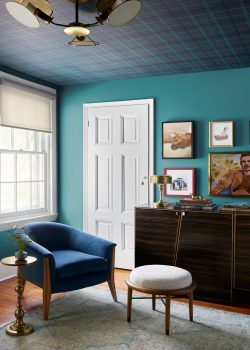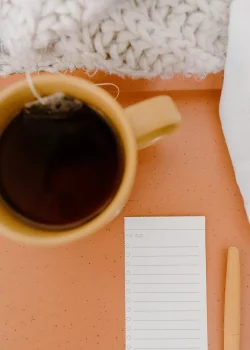Match Made in Heaven: When Designers and Professional Organizers Collaborate

It should come as no surprise that The Container Store is my happy place. I can wax eloquent on the pros and cons of almost any item sold there. I know what works and what doesn’t. Put me in a home décor store, however, and I walk around in a confused daze. I am no longer operating in my ‘zone of genius’ to borrow a phrase from Michelle Gage, owner of Michelle Gage Interiors https://michellegage.co/
Some of my favorite projects involve the collaboration between The Organizing Professionals® and local interior designers.
Edit Before Design: Suzy (not her real name) wants to decorate her home. She contacts her Designer who comes out to do a consult. There are boxes and bags crammed in all kinds of nooks and crannies. The Designer realizes Suzy’s first step is to do a thorough declutter before the project can begin. This is where we step in. The Organizing Professionals® work with Suzy on a thorough edit of the rooms she plans to decorate. Not only does this bring Suzy the peace of mind that comes from letting go of items she no longer loves, needs, and uses, she is able to make better decisions regarding the design and function of the space. Suzy and her Designer are now able to better focus on design that fits her needs.
Pack & Label: When the project is about to start, Suzy is able to get on with her busy life while we pack and label all the contents from each room. We can also create a detailed box inventory. So, if Suzy happens to need something packed during the project, she can easily locate it.
Post-Decoration and Installation: Here’s where the magic occurs. Suzy’s decoration project is complete and looks amazing, but she has neither the time, energy, nor organizing expertise to unpack and put away all those boxes. We return and take it one step further. Whether it’s a kitchen, closet, or bathroom (or anything in between!) every item is put away and perfectly organized. Clothes are categorized and hung on matching hangers in color order. We strategically organize kitchen items with systems that work for Suzy and how she functions in her kitchen. Effective collaboration with an interior designer means he or she has sourced the perfect dresser and/or credenza giving Suzy beautiful pieces that provide storage solutions. If organizing products are needed to corral items, we have the experience and knowledge as to what works. We shop, deliver, and install those products too.
While Suzy’s Designer focuses on creating a beautiful aesthetic, we look to maximize the space and concentrate on the function. Suzy benefits from both our unique skill sets. The result is a space that’s beautiful yet practical for everyday living.
Check out our recent tips featured in Homes and Gardens

Organizing makeup so it’s neat, tidy and well-ordered is the best way to streamline your beauty routine. However, with varying sized tubes, tubs, palettes, bottles and brushes, implementing a system that’s both practical and aesthetically pleasing can feel like a challenge.
Organizing a bedroom (or makeup room, depending on where you store your makeup) to its best potential is the best place to start. Whether you have an extensive collection or a few core cosmetics you use every day, they should be easy to find, easy to access and easy to keep neat and tidy.
How Do You Know If You’re Too Sentimental? (Or… The Art of Letting Go)

We all have them; people in our lives who, when you confess your inner struggle about holding onto something that really needs to go, coldly state, “Just throw it out. Nobody is going to want that!” Those people are not reading this blog due to obvious reasons (the title). The rest of you dear ones, welcome! And let’s discuss…
While I’m not a psychologist, I spend a good deal of time helping clients let go of items to which they have an emotional attachment. Items typically fall into the following categories:
Memories – Let’s face it, anything can fall into this category, photos, a piece of clothing, books, furniture. We hold onto items that trigger a happy or satisfying memory. A T-shirt of a particular place, club, or activity. A favorite book, a piece of heirloom furniture, or a tchotchke from a trip.
Guilt – Then there are items we’re not necessarily emotionally connected to. You may not even like them (such as gifts) but the thought of letting the item go gives you so much guilt they reside for years as unwanted guests in your home. And how about expensive purchases? Maybe it was an impulse buy or merely something that is now dated but cost so much, you just can’t bring yourself to let it go.
Obligation – You may not be attached to items in this category, but you’re holding on to them out of a sense of obligation or guilt (again!) This can include every piece of artwork your child has drawn and decorative items to pass down to other family members.
This is not supposed to be an exhaustive list of reasons why folks hold onto items. Entire books have been written on the subject. But let’s return to the title of this article. What should be the standard to measure whether someone is too sentimental? I believe everyone has the right to hold onto whatever they choose unless it affects relationships with other family members or interferes with the amount of space needed to live safely and comfortably in their home. These are usually the reasons clients reach out to us for help and here are three helpful mantras we use:
“If I keep everything then nothing is special.” Realistically, how often are you (or your kids) going to open all those memory tubs in your attic? Choose a few select items from departed family members, take photos of clothes you are holding onto for just their memory value, digitize your print photos and home videos. Accept that the photos of your trip are all the memories you need and it’s okay to let go of all the other souvenirs.
“If I don’t love it, need it, or use it, it doesn’t deserve a place in my home.” Sentimental types often avoid taking stock of what they have. Decluttering means having to deal with uncomfortable emotions. Using this mantra gives a set of guidelines and makes the process a little easier.
“I will declutter without guilt.” This mantra is really an addendum to the previous one. Regardless of who gifted the item or how expensive it was, your home should be filled with items loved, needed, and used by the people living in your home. The occasional unwanted gift displayed or used to please a visiting friend or family member is fine. Cluttering your home with heaps of unwanted items is not.
If you feel you would benefit from the emotional support we provide through our decluttering services, please reach out to us. We are here to help!
Happy Decluttering!
Janet
The One Organizing Mistake You Need to Avoid

Do you have a gargantuan organizing project you’ve been putting off because you don’t have time to do it? Don’t we all? We tend to approach large projects as a task that needs to be accomplished when we have a large chunk of time. I am guilty of this mistake also, but not anymore! Being extremely goal-oriented, I would wait until I had several hours before tackling a large task so I’d be able to complete it in totality. I then realized I was procrastinating because,
a. I didn’t have enough time to complete the task or,
b. I didn’t want to do it
I now divvy up almost any task into small time increments. Almost any task can be broken into bite-size pieces. A few examples:
- Organize an area of your house. Instead of dedicating an entire weekend to address a particular area, break it up into 30-minute sessions. Four thirty-minute sessions totals two hours of organizing if you do it four times a week, and a whopping eight hours if you do it over an entire month! You can do anything for thirty minutes so that daunting project you were dreading now becomes attainable.
- Pet-hate chores. As my family can attest, I have many pet-hate household chores. Folding laundry is one of them. I have now taken to divvying up folding laundry. Each time I go upstairs, I take several items out of the clean laundry basket and fold them. It takes less than 30 seconds. By the end of the day, a chore I was neglecting is now complete and my laundry folded and put away. (I’m embarrassed to admit this, but I do the same with emptying the dishwasher!)
I figured if this strategy works for me—a lifelong goal-oriented person who likes to devote large amounts of time to a project—it will most likely work for many other task-driven individuals.
Last year, I began a full house decluttering project. Armed with bags for trash and donation, I set a timer for 30 minutes and began decluttering my nightstand. When the timer went off, I stopped decluttering and continued the following day. Some weeks, I carved out more 30-minute sessions but even if I were on a roll I would stop after 30-minutes. I knew this would incentivize me to continue since I hate not completing a project.
Within a couple of months, our entire top floor was decluttered, and the organization of every room was improved. So, if you find it challenging to start a project, or even complete a project, give this strategy a try and let me know how you get on!
Happy organizing!
Janet
Haverford Trust recently asked me to speak at their Women’s Speaker Series event at the Sofitel in Philadelphia. Here’s a short two-minute clip from the event where I discuss this very topic.
Check Out Janet’s Tips in MGI’s Guide to Moving

When planning a move, figuring out where to begin can be overwhelming. Janet Bernstein, owner of The Organizing Professionals recommends, “Start decluttering yesterday! Moving is the perfect time for a fresh start and your rule of thumb should be not to take anything that you don’t love, need or use. Pace yourself and try to declutter a room or at least an area at a time.”